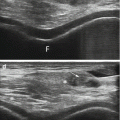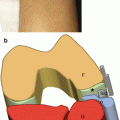Fig. 1.1
(a) With US-guided lateral approach, the needle is inserted on the short side of the probe allowing for an excellent visibility. (b) With US-guided coaxial approach, the needle is inserted on the long side of the probe, allowing for a reduced path in soft tissues but visibility is limited only to the tip
Drugs
Local Anesthetics
US-guided interventional procedures may require local anesthesia to minimize pain and discomfort. The type and amount of anesthetic used depends largely on the procedure itself and the involved anatomical location.
The effect of local anesthetics is given by their ability of interrupting neural conduction, by inhibiting the sodium channels. In most cases, this inhibitory activity follows their diffusion through the neural membrane into the axoplasm, where they enter sodium channels. The local anesthetic molecule consists of three different components, the combination of them giving specific properties to the molecule. The lipid solubility of the compound enhances diffusion through both nerve sheaths and the neural membranes of the individual axons comprising a nerve trunk. This property correlates with drug power, as the higher the liposolubility, the greater portion of drug enters neurons.
Fast-acting local anesthetics, such as a 2 % lidocaine solution, are injected with a small needle around and within the area to be treated. Patients will initially experience a brief stinging sensation related to the needle and the anesthetic being introduced; bicarbonate buffering significantly reduces this type of sensation. We use a mixture of one part of bicarbonate every four parts of anesthetic. Within seconds, typically, the area becomes numb. Lidocaine solutions are also an option for US-guided diagnostic nerve blocks, with the anesthetic injected around the nerve over the level of the suspected pathology.
Long-acting local anesthetics, such as a 0.25 % bupivacaine hydrochloride solution, are injected in association with corticosteroids for local relief at sites of musculoskeletal discomfort (articular and extra-articular) and for therapeutic nerve blocks.
Permanent side effects are extremely uncommon provided that maximum doses are respected. Temporary effects may be experienced by patients that may include:
Numbness of the tongue
Dizziness
Blurred vision
Muscle twitching
Local anesthetics depress the central nervous system dose dependently. A maximum dose of 20-ml 2 % lidocaine can be considered safe and more than sufficient for most local musculoskeletal procedures.
Some patients may claim that they are allergic to local anesthetics. Upon careful questioning, however, it becomes clearer that they experienced vagal reactions related to the injection procedure or cardiac palpitations attributed to epinephrine either contained in the solution or released endogenously. Although rare, allergic reactions to local anesthetics have been reported in the scientific literature, but in none of these cases was there a confirmed IgE-mediated hypersensitivity reaction. Nevertheless, patients have occasionally experienced symptoms consistent with an allergic reaction to amide local anesthetics. Usually, asking patients whether they had ever experienced any problems with dental anesthesia is a reliable diagnostic test.
Corticosteroids
Inflammation is one of the body’s first reactions to injury. Increase in local blood flow transports polymorphonuclear leukocytes, macrophages, and plasma proteins to the injured area, where arteriolar flow is redistributed thus producing stasis and hypoxia at the injury site. The resulting infiltration of the affected tissues by leukocytes, plasma proteins, and fluid causes the redness, swelling, and pain that are the typical features of inflammation.
In the musculoskeletal system, different causes of inflammation can be found, including arthritis, tenosynovitis, bursitis, and trauma. It has also been shown that inflammation is present in other diseases that have been traditionally regarded as degenerative, such as osteoarthritis.
In degenerative/overload tendinopathy, no inflammatory cells are usually seen. However, angiofibroblastic proliferation can be frequently seen.
Stay updated, free articles. Join our Telegram channel

Full access? Get Clinical Tree








